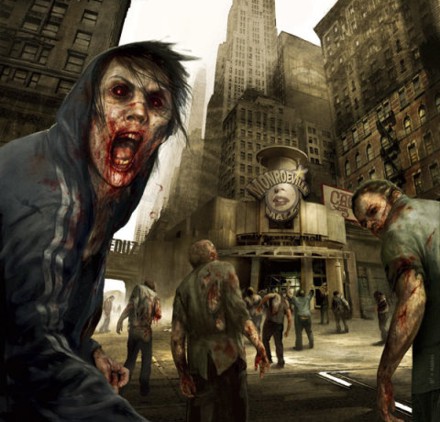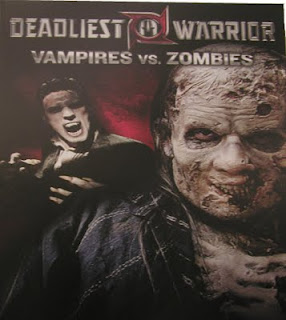Tag Archives: vampires
ZOMBIE HISTORY – The Plague That Is Zombies
 ‘I hereby resolve to kill every vampire in America” writes the young Abraham Lincoln in the best-selling 2010 novel “Abraham Lincoln: Vampire Hunter.” Honest Abe doesn’t quite make good on his promise, and the grim results are all around us. Today, vampires spring from the shadows of our popular culture with deadening regularity, from the Anne Rice novels to the Twilight juggernaut to this year’s film adaptation about the ghoul-slaying Great Emancipator. Lately we’ve also endured a decadelong bout with the vampire’s undead cousin, the zombie, who has stalked films from “28 Days Later” to “Resident Evil” (the next sequel of which is due out this fall) and the popular TV show “The Walking Dead.”
‘I hereby resolve to kill every vampire in America” writes the young Abraham Lincoln in the best-selling 2010 novel “Abraham Lincoln: Vampire Hunter.” Honest Abe doesn’t quite make good on his promise, and the grim results are all around us. Today, vampires spring from the shadows of our popular culture with deadening regularity, from the Anne Rice novels to the Twilight juggernaut to this year’s film adaptation about the ghoul-slaying Great Emancipator. Lately we’ve also endured a decadelong bout with the vampire’s undead cousin, the zombie, who has stalked films from “28 Days Later” to “Resident Evil” (the next sequel of which is due out this fall) and the popular TV show “The Walking Dead.”
Purists will hold forth on the differences between vampire and zombie, but the family resemblance is unmistakable. Both are human forms seized by an animal aggression, which manifests itself in an insatiable desire to feed on the flesh of innocents. (Blood, brains, whatever; it’s a matter of taste.) Moreover, that very act of biting, in most contemporary versions of both myths, transforms the victims into undead ghouls themselves.
Our vampires and zombies (as well as such poor relations as werewolves) all serve as carriers for vaguely similar saliva-borne infections. These mythical contagions are especially odd because they have so few analogues in the natural world. Indeed, there is really only one: the rabies virus.
A fatal infection of the brain, rabies is particularly devastating to the limbic system, one of the most primitive parts of the brain. Fear, anger and desire are hijacked by the virus, which meanwhile replicates prolifically in the salivary glands. The infected host, deprived of any sense of caution, is driven to furious attack and sometimes also racked with intense sexual urges. Today we know that most new diseases come from our contact with animal populations, but with rabies this transition is visible, visceral, horrible. A maddened creature bites a human, and some time later, the human is seized with the same animal madness.
Known and feared for all of human history—references to it survive from Sumerian times—rabies has served for nearly as long as a literary metaphor. For the Greeks, the medical term for rabies (lyssa) also described an extreme sort of murderous hate, an insensate, animal rage that seizes Hector in “The Iliad” and, in Euripides’ tragedy of Heracles, goads the hero to slay his own family. The Oxford English Dictionary documents how the word “rabid” found similar purchase in English during the 17th century, as a term of illness but also as a wrenching state of agitation: “rabid with anguish” (1621), “rabid Griefe” (1646).
The roots of the vampire myth stretch back nearly as far. Tales of vampire-like creatures, formerly dead humans who return to suck the blood of the living, date to at least the Greeks, before rumors of their profusion in Eastern Europe drifted westward to capture the popular imagination during the 1700s.
In its original imagining, though, the premodern vampire differed from today’s in one crucial respect: His condition wasn’t contagious. Vampires were the dead, returned to life; they could kill and did so with abandon. But their nocturnal depredations seldom served to create more of themselves.
All that changed in mid-19th century England—at the very moment when contagion was first becoming understood and when public alarm about rabies was at its historical apex. Despite the fact that Britons were far more likely to die from murder (let alone cholera) than from rabies, tales of fatal cases filled the newspapers during the 1830s. This, too, was when the lurid sexual dimension of rabies infection came to the fore, as medical reports began to stress the hypersexual behavior of some end-stage rabies patients. Dubious veterinary thinkers spread a theory that dogs could acquire rabies spontaneously as a result of forced celibacy.
Thus did rabies embody the two dark themes—fatal disease and carnal abandon—that underlay the burgeoning tradition of English horror tales. Britain’s first popular vampire story was published in 1819 by John Polidori, formerly Lord Byron’s personal physician. The sensation it caused was due largely to the fact that its vampire, a self-involved, aristocratic Lothario, distinctly resembled the author’s erstwhile employer.
But Polidori’s Byronic ghoul only seduced and killed. It took until 1845, with the appearance of James Malcolm Rymer’s serialized horror story “Varney the Vampire,” for the vampire’s bite to become a properly rabid act of infection. For the first time readers were invited to linger on the vampire’s teeth, which protrude “like those of some wild animal, hideously, glaringly white, and fang-like.” And at the long tale’s end, Varney’s final victim (a girl named Clara) is herself transformed into a vampire and has to be destroyed in her grave with a stake.
Both these innovations carried over into the most important vampire tale of all, Bram Stoker’s “Dracula.” In Stoker’s hands, the vampire becomes a contagious, animalistic creature, and his condition is properly rabid. It is a lunge too far to claim (as one Spanish doctor has done in a published medical paper) that the vampire myth derived literally from rabies patients, misunderstood to be the walking dead. But it is clear that this central act of undead fiction—the bite, the infection, the transferred urge to bite again—has rabies knit into its DNA.
Over time, the vampire’s contagion infected his undead cousin, too. The original zombie myth, as it derived from Haitian lore, also involved the dead brought back to kill, but again without contagion—an absence that carried over to Hollywood’s earliest zombie flicks. In this and many other regards, the most influential zombie tale of the 20th century was nominally a vampire tale: Richard Matheson’s 1954 novel “I Am Legend,” whose marauding hordes of contagious “vampires,” victims of an apocalyptic infection, set the whole template for what we now think of as the standard zombie onslaught.
Since then, as Hollywood has felt the need to conjure ever more frightening cinematic menaces, the zombie has if anything grown increasingly rabid. The antagonists in Matheson’s novel can, at times, carry on an intelligent conversation with a normal human. By the 2007 film adaptation, starring Will Smith, the infected are howling, lunging, senselessly hateful animals inside a human form. Danny Boyle, the director of “28 Days Later,” has said outright that he modeled his zombie virus on rabies. But even if he hadn’t consciously done so, the name he gave that virus—”Rage”—already draws its power from the same centuries-old supply.
Westerners don’t have much cause to fear death from rabies these days. Thanks to the availability of vaccine, human fatalities in the U.S. have dropped to a handful per year; Britain got rid of the virus entirely in 1902, succeeding in just the sort of national eradication project that apparently stymied the vampire-slaying Abraham Lincoln. Yet the infected bite, the human turned animal aggressor, menaces us as often as ever on our flat screens and nightstands.
Rabies itself may be a distant concern, but the rabid idea, like Varney the vampire, still has teeth—and it still succeeds in spreading itself.
Best Car to Survive a Zombie Apocalypse
-
 Conquest Vehicles
Conquest Vehicles
Now that the Centers for Disease control has warned Americans to prepare for a possible “Zombie Apocalypse,” it may be a good time to rethink your upcoming automobile purchase.
If Hollywood has thought us anything over the years it’s that, while they are very susceptible to baseball bats, zombies are adept at jumping on cars and breaking through their windows in order to eat the brains of their occupants. Not to fear, there’s one vehicle that should keep your noggin intact.
The Knight XV from Conquest Vehicles wasn’t designed with the undead in mind (at least we don’t think that it was) but the mega-SUV is perfectly suited to the task at rotting hand. About twice the size of your typical HUMMER, the fully-armored truck could likely survive an assault by Team 6, let alone cracked fingernails.
Its opaque bullet-proof glass will keep you out of sight of glazed-over eyes, while ballistic run-flat tires should have no problem driving over the unkempt, bone-strewn streets of your town. It even runs on bio-diesel, so when the supplies run dry you can make your own fuel. Night-vision surveillance cameras and an external listening device serve as an early warning system and a high-power roof-mounted spotlight is just the ticket in case a few vampires find their way into the mix. Hey, you never know.
Granted, the price of survival is high at $300,000, but that’s about how much a three-bedroom costs in Pittsburgh – the location of “Night of the Living Dead” – and you won’t need one if you drive one of these. Its interior is upholstered in leather and Wilton Wool, comes with a flat-screen TV, refreshment bar and satellite TV to pick up the signal from any other survivors who might be out there.
Unfortunately, there’s no bathroom, so good luck with that. But it does come with a cigar humidor so you can live the good life to the fullest while you’re still alive. Hurry up, though, only 100 will be made and you don’t want to be the one stuck driving around in a convertible.
THE DEAD SHALL RISE – Vampire skeletons discovery comes after zombie apocalypse scare
 A discovery of vampire skeletons by scientists were found in Bulgaria. New of this comes on the heels of a bizarre zombie apocalypse scare from last week.
A discovery of vampire skeletons by scientists were found in Bulgaria. New of this comes on the heels of a bizarre zombie apocalypse scare from last week.
Archaeologists believe they’ve discovered centuries-old skeletons that were pinned down with iron rods going through their chests. It was a ritual done to the dead so they wouldn’t turn into vampires, FOX reports. The practice occurred in certain parts of Bulgaria and continued up until the turn of the last century.
Two skulls were found over the weekend near the Black Sea town of Sozopol in Bulgaria.
At the time time there was superstition that those who did evil when they were alive, would return from the dead and feast on the living’s blood. This prompted the hammering of iron rods through the dead’s chest bones and hearts.
Over 100 corpses around Bulgaria have been found stabbed as a way to prevent them from becoming vampires.
The latest news is a slight distraction from the horrific zombie apocalypse-like incidents that took place throughout the U.S. and Canada last week. At least this discovery is about skeletons, archaic beliefs, and traditional practices of the old ages. It’s seemingly less shocking compared to cannibalism!